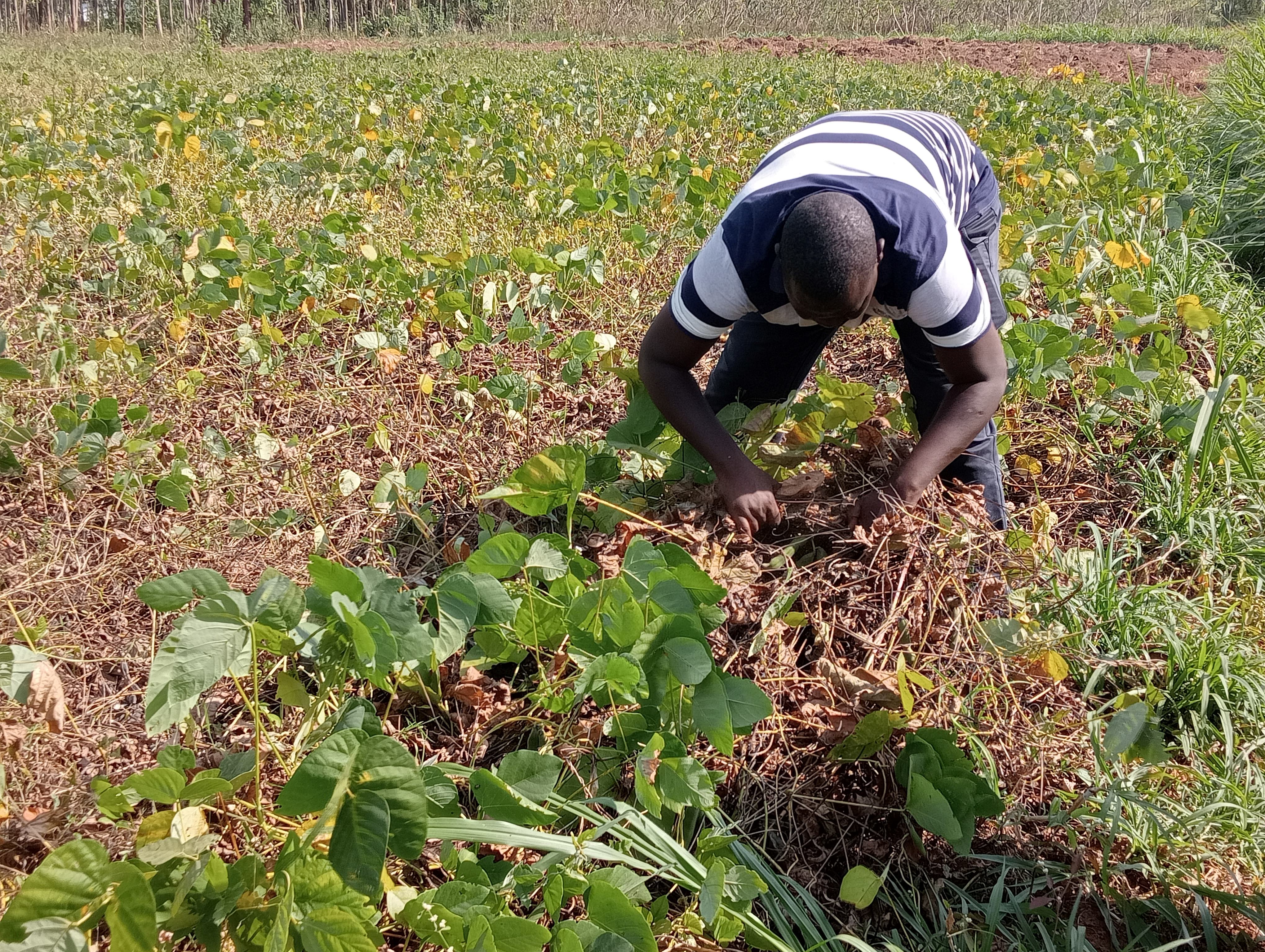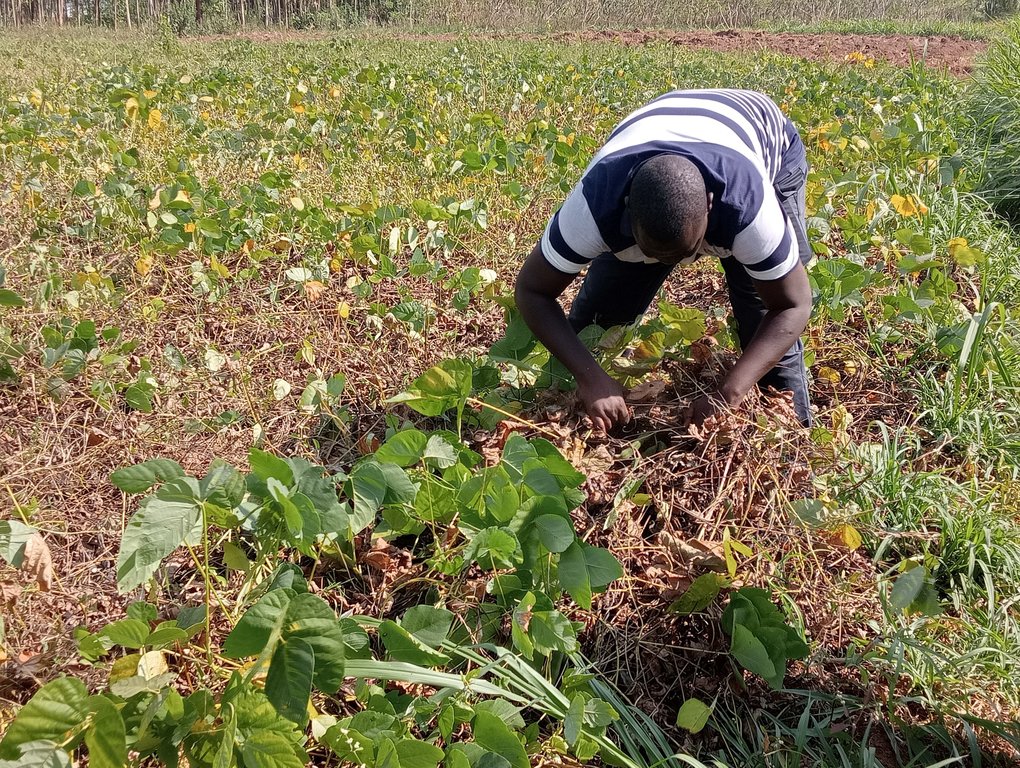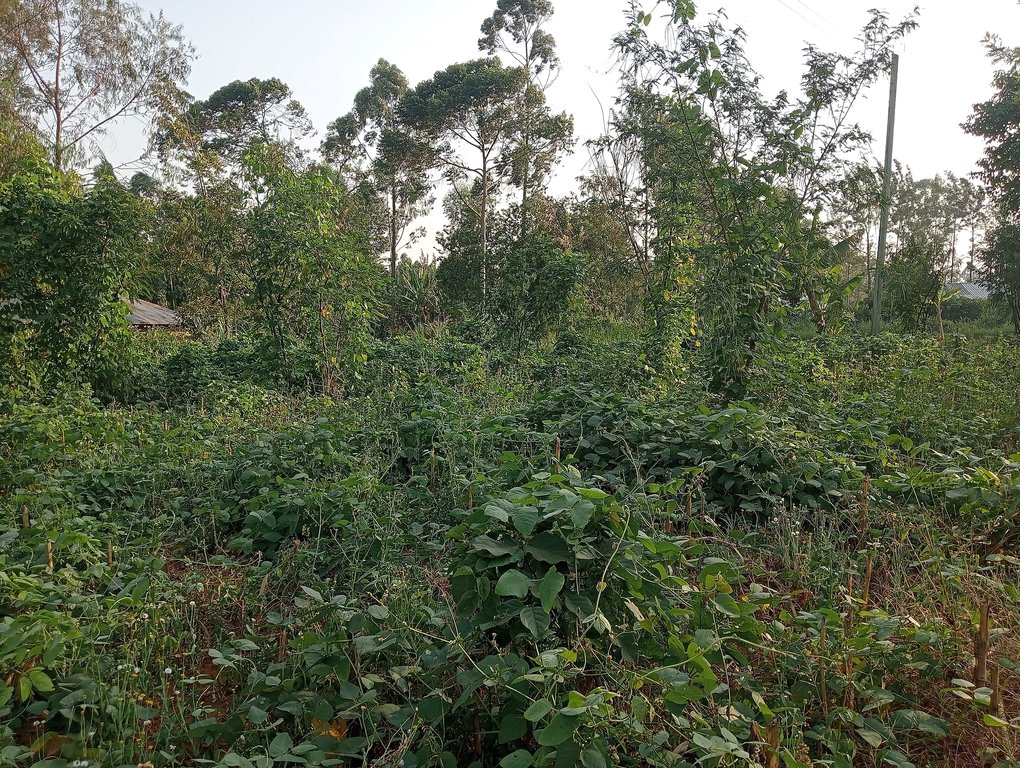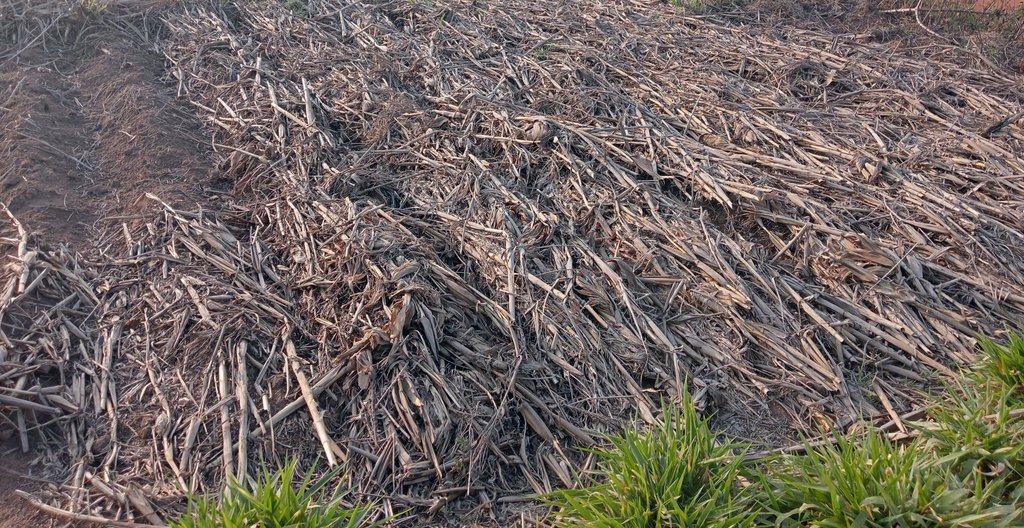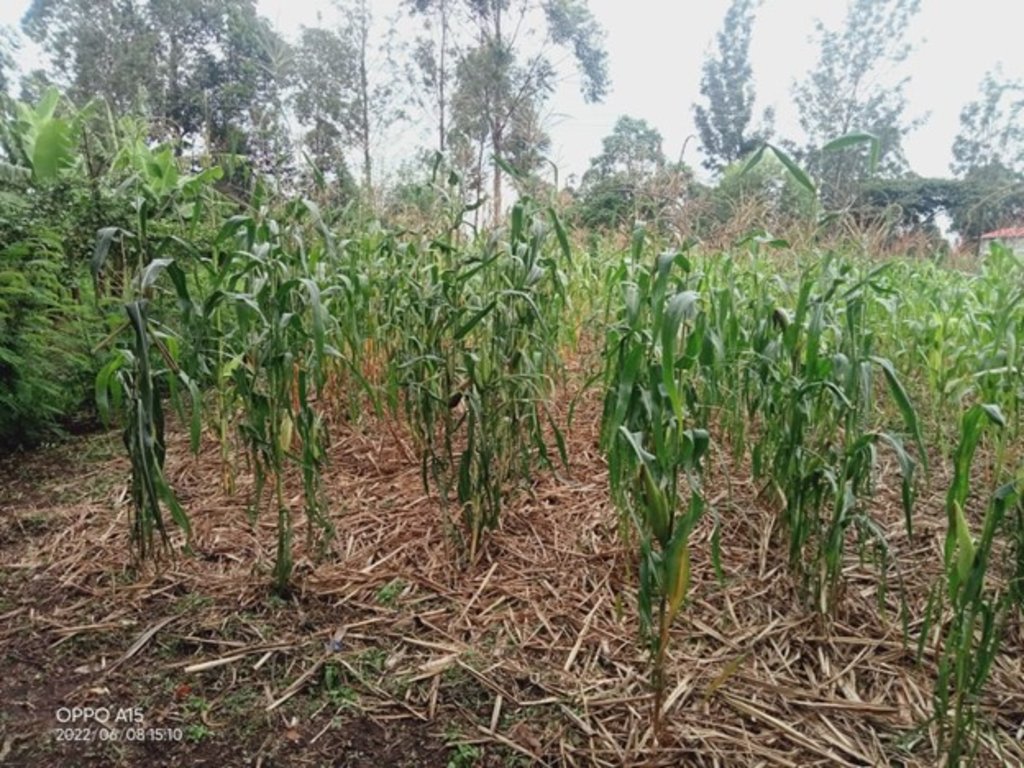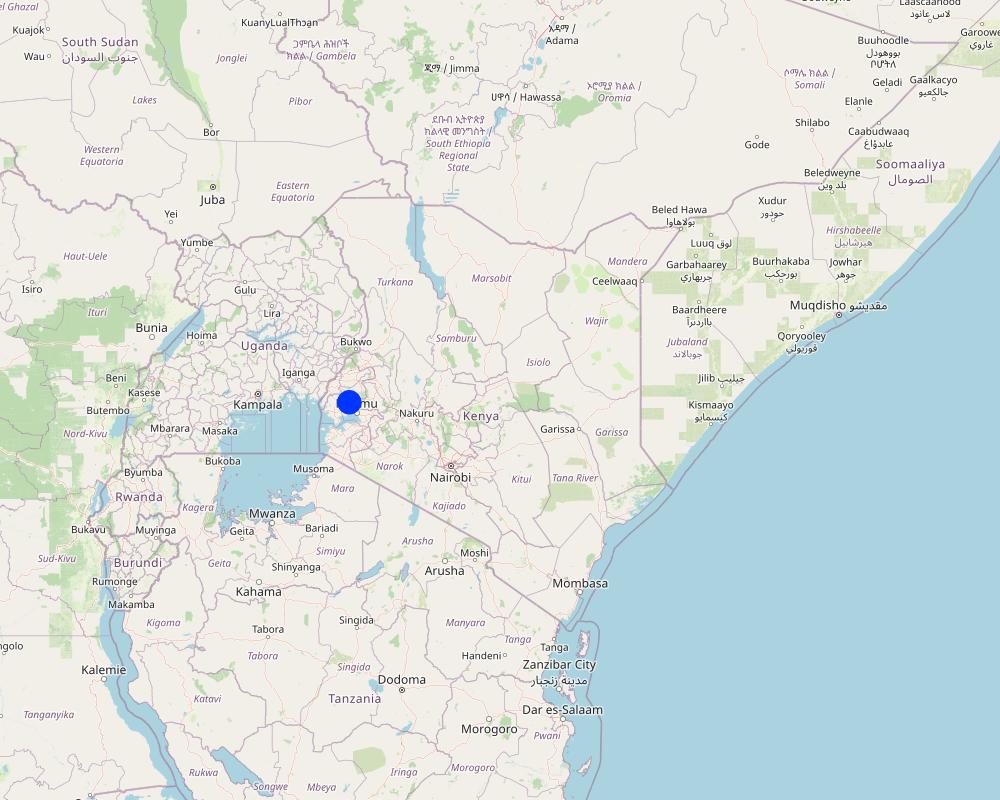Permanent soil cover [肯尼亚]
- 创建:
- 更新:
- 编制者: William Akwanyi
- 编辑者: Innocent Faith, Noel Templer, Leah Munala, Tabitha Nekesa, Ahmadou Gaye, Siagbé Golli
- 审查者: William Critchley, Rima Mekdaschi Studer, Sally Bunning
technologies_6699 - 肯尼亚
查看章节
全部展开 全部收起1. 一般信息
1.2 参与该技术评估和文件编制的资源人员和机构的联系方式
关键资源人
土地使用者:
Onjili Jared Kochwa
GFA farmer
肯尼亚
SLM专业人员:
SLM专业人员:
有助于对技术进行记录/评估的项目名称(如相关)
Soil protection and rehabilitation for food security (ProSo(i)l)有助于对技术进行记录/评估的机构名称(如相关)
Deutsche Gesellschaft für Internationale Zusammenarbeit (GIZ)有助于对技术进行记录/评估的机构名称(如相关)
CIAT International Center for Tropical Agriculture (CIAT International Center for Tropical Agriculture) - 肯尼亚1.3 关于使用通过WOCAT记录的数据的条件
编制者和关键资源人员接受有关使用通过WOCAT记录数据的条件。:
是
1.4 所述技术的可持续性声明
这里所描述的技术在土地退化方面是否存在问题,导致无法被认为是一种可持续的土地管理技术?:
否
注释:
Farmers who have implemented the technology have recorded an increase in crop production. The technology has not adversely affected their farms.
1.5 参考关于SLM方法(使用WOCAT记录的SLM方法)的调查问卷
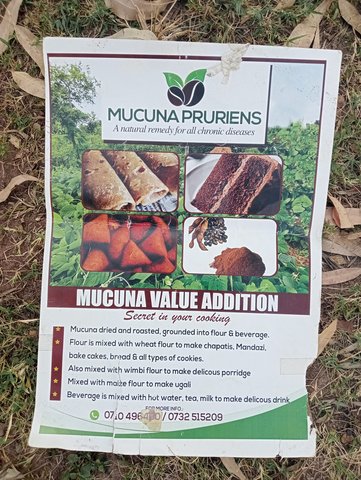
Mucuna value-addition for female farmers [肯尼亚]
Promoting mucuna seed processing for food and nutrition security and income generation encourages women farmers to plant mucuna as a cover crop that improves soil productivity.
- 编制者: William Akwanyi
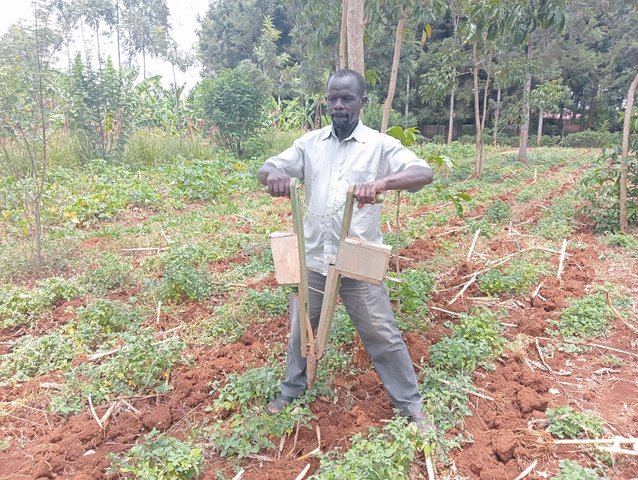
Improving farmers' access to tools for conservation agriculture [肯尼亚]
Improving farmers' access to minimum tillage tools is an approach to increasing the adoption of conservation agriculture (CA) through linking them to institutions that fabricate the tools.
- 编制者: William Akwanyi
2. SLM技术的说明
2.1 技术简介
技术定义:
Permanent soil cover with cover crops and/or crop residues helps to control soil erosion, suppress weeds and build up soil fertility. It can also add organic matter to the soil.
2.2 技术的详细说明
说明:
Permanent soil cover is having all-year-round cover on the soil. This can be either in the form of cover crops which are either planted with other crops at the same time, or relay planted later in the season after the main crops have established, or in the form of crop residues (mulch) which is naturally decomposed by microbes. Permanent soil cover provides a shield or umbrella to the soil protecting it from the heat of the sun and the impact of rain. It makes up a fundamental component of conservation agriculture where minimum tillage reduces soil disturbance.
Some of the crops used for permanent soil cover [those promoted by the ProSoil project] include Mucuna pruriens (velvet bean), Canavalia ensiformis, Dolichos lablab, and Desmodium intortum. All of these are legumes, which fix nitrogen from the atmosphere, thus improving soil fertility. In choosing a cover crop, farmers prefer those that fit into their normal cropping systems, and which have multiple purposes, including those that produce edible seeds and vegetables, those that improve soil fertility, those that can be used as animal fodder, and those that can suppress weeds. Some farmers prefer crops that can provide firewood or fencing material and those that can be used for medicinal purposes. Another important factor that farmers consider when choosing a cover crop is the amount and type of work that the cover crop will need, for example for land preparation before planting, weeding, and producing and harvesting the seeds. The crops most preferred are those that cover the soil quickly and completely, and which can also be used for food and fodder, including mucuna. Farmers also like mucuna because of its big pods and grains that are easier to deal with. Farmers can easily multiply mucuna seeds since they do not require complicated treatments; hence, do not need to continue spending money on the seeds.
In establishing a permanent soil cover using cover crops, farmers first intercrop seasonal crops (e.g., maize and beans) and later introduce a green manure cover crop (e.g., mucuna) after about 6 weeks (or at the time when the beans start to produce pods) to ensure that the green manure cover crop does not suppress the main crop(s). The maize is planted at 75 cm row spacing and 25 cm between plants in the same row. However, within each row, the third hole/ space is left for the cover crop (i.e., mucuna). Thus, mucuna is planted after every three maize plants in the same row. The bean intercrop is planted between the maize rows at the spacing of 37.5 cm from the maize row and 20 cm between bean plants in the same row. This spacing requires about 5 kg of cover crop (mucuna) seeds per acre. The crops continue to grow together and upon harvesting the main crops, the cover crop continues to grow on the farm covering the soil until the following cropping season.
Permanent soil cover is beneficial in the farm in various ways including, enhancing soil water infiltration, protecting soil from agents of erosion, increasing soil organic matter, suppressing weeds, aiding in nutrient cycling, and improving the habitat of soil micro- and macro-organisms. Maintaining permanent soil cover through mulching faces some limitations, including competing uses of crop residues e.g., as animal feeds and fuel. Similarly, drought may be a major limitation to maintaining permanent soil cover using cover crops, especially in areas that receive very low rainfall and where the farmer has not invested in irrigation.
2.3 技术照片
2.5 已应用该技术的、本评估所涵盖的国家/地区/地点
国家:
肯尼亚
区域/州/省:
Kakamega County in western Kenya
有关地点的进一步说明:
Kisa Central Ward in Khwisero Sub-county; and Koyonzo and Khalaba wards in Matungu Sub-county
具体说明该技术的分布:
- 均匀地分布在一个区域
技术现场是否位于永久保护区?:
否
注释:
There are no protected areas in the areas covered by this assessment. The indicated area is the total for the three farms which were used in the documentation. Most of the information was collected from the farm in Khwisero Sub-county. Some photos were taken from the two farms in Matungu Sub-county.
Map
×2.6 实施日期
注明实施年份:
2021
2.7 技术介绍
详细说明该技术是如何引入的:
- 作为传统系统的一部分(> 50 年)
- 通过项目/外部干预
注释(项目类型等):
The farmers were already growing cover crops such as sweet potatoes and pumpkins. The ProSoil project introduced the farmers to other soil cover crops such as mucuna and desmodium.
3. SLM技术的分类
3.1 该技术的主要目的
- 改良生产
- 减少、预防、恢复土地退化
- 保护生态系统
- 保持/提高生物多样性
- 适应气候变化/极端天气及其影响
3.2 应用该技术的当前土地利用类型
同一土地单元内混合使用的土地::
是
具体说明混合土地使用(作物/放牧/树木):
- 农林牧业

农田
- 一年一作
- 多年一作(非木材)
- 乔木与灌木的种植
年作 - 具体指明作物:
- 饲料作物 - 其他
- 饲料作物 - 草
- 谷物类 - 玉米
- 蔬菜 - 其他
- 蔬菜 - 香瓜、南瓜、南瓜或葫芦
- 豆科牧草和豆类 - 豆子
年作制度:
玉米/高粱/谷子与豆类间作
多年生(非木质)作物 - 指定作物:
- 香蕉/芭蕉/蕉麻
- 饲料作物 - 草
- fodder crops - legumes, clover
乔木和灌木种植 - 指定作物:
- 饲料树木(朱缨花属、银合欢、前庭草等)
- 鳄梨
- 水果、其他
- 芒果、山竹果、番石榴
- 木瓜
每年的生长季节数:
- 2
具体说明:
Crops are grown during the long and short rain seasons.
采用间作制度了吗?:
是
如果是,说明哪些作物是间作的:
Maize and legumes (beans)
采用轮作制度了吗?:
是
如果是,请具体说明:
Mucuna is left to continue covering the soil after the main crop(s) has/ have been harvested.

牧场
集约放牧/饲料生产:
- 收割和携带/零放牧
- 改良牧场
动物类型:
- 牛 - 奶制品
- cattle - dairy and beef (e.g. zebu)
- 家禽
是否实行作物与牲畜的综合管理?:
是
如果是,请具体说明:
Manure from livestock is applied to the crop fields.
产品和服务:
- economic security, investment prestige
- 奶类
- manure as fertilizer/ energy production
- 蛋类
- 肉类
品种:
牛 - 奶制品
计数:
1
品种:
cattle - dairy and beef (e.g. zebu)
计数:
2
品种:
家禽
计数:
20
3.3 由于技术的实施,土地使用是否发生了变化?
由于技术的实施,土地使用是否发生了变化?:
- 否(继续问题3.4)
3.4 供水
该技术所应用土地的供水:
- 雨养
注释:
Crop establishment is dependent on availability of rainfall.
3.5 该技术所属的SLM组
- 改良的地面/植被覆盖
- 最小的土壤扰动
- 土壤肥力综合管理
3.6 包含该技术的可持续土地管理措施

农艺措施
- A1:植被和土壤覆盖层
- A2:有机质/土壤肥力
- A3:土壤表面处理
- A6:残株管理
A3:区分耕作制度:
A 3.1:免耕
A6:对残株管理作出具体说明:
A 6.4:保留
注释:
Permanent soil cover is normally associated with reduced or zero tillage.
3.7 该技术强调的主要土地退化类型

土壤水蚀
- Wt:表土流失/地表侵蚀

土壤风蚀
- Et:表土流失

化学性土壤退化
- Cn:肥力下降和有机质含量下降(非侵蚀所致)

物理性土壤退化
- Pc:压实

生物性退化
- Bc:植被覆盖的减少
- Bs:质量和物种组成/多样性的下降

水质恶化
- Ha:干旱化
3.8 防止、减少或恢复土地退化
具体数量名该技术与土地退化有关的目标:
- 防止土地退化
- 适应土地退化
4. 技术规范、实施活动、投入和成本
4.1 该技术的技术图纸
技术规范(与技术图纸相关):
Maize/ mucuna spacing: row to row = 75 cm, plant to plant in the same row = 25 cm, mucuna planted in every third hole/ space in the same row
Bean spacing: bean rows between the maize/ mucuna rows, bean row to maize/ mucuna row = 37.5 cm, plant to plant in the same row = 20 cm
作者:
William Akwanyi
日期:
04/07/2023
4.2 有关投入和成本计算的一般信息
具体说明成本和投入是如何计算的:
- 每个技术区域
注明尺寸和面积单位:
1 acre
其它/国家货币(具体说明):
KES
如相关,注明美元与当地货币的汇率(例如1美元=79.9巴西雷亚尔):1美元=:
124.21
注明雇用劳工的每日平均工资成本:
KES 250.00
4.3 技术建立活动
注释:
Land preparation in a conservation agriculture situation will only involve mowing and sub-soiling that are less costly than plouging.
4.5 维护/经常性活动
| 活动 | 时间/频率 | |
|---|---|---|
| 1. | Land preparation | Before rains |
| 2. | Planting | After rains |
| 3. | Shallow weeding | During the second weeding of the main crop at 1.5 months |
| 4. | Uncoiling (e.g., mucuna from the main crop) | Bi-weekly |
4.6 维护/经常性活动所需要的费用和投入(每年)
| 对投入进行具体说明 | 单位 | 数量 | 单位成本 | 每项投入的总成本 | 土地使用者承担的成本% | |
|---|---|---|---|---|---|---|
| 劳动力 | Slashing | Man-days | 5.0 | 250.0 | 1250.0 | 100.0 |
| 劳动力 | Sub-soiling | Man-days | 10.0 | 250.0 | 2500.0 | 100.0 |
| 劳动力 | Planting | Man-days | 4.0 | 250.0 | 1000.0 | 100.0 |
| 劳动力 | Shallow weeding and uncoiling (e.g., mucuna from the main crop) | Man-days | 9.0 | 250.0 | 2250.0 | 100.0 |
| 设备 | Slasher | No. | 1.0 | 70.0 | 70.0 | |
| 设备 | Hand-held sub-soiler | No. | 1.0 | 70.0 | 70.0 | |
| 设备 | Jab planter | No. | 1.0 | 1000.0 | 1000.0 | |
| 设备 | Shallow weeder | No. | 1.0 | 80.0 | 80.0 | |
| 植物材料 | Cover crop seeds | Kgs | 5.0 | 150.0 | 750.0 | |
| 技术维护所需总成本 | 8970.0 | |||||
| 技术维护总成本,美元 | 72.22 | |||||
如果土地使用者负担的费用少于100%,请注明由谁负担其余费用:
ProSoil through GFA
注释:
The farmer does not need fertilizer and manure for planting mucuna. The ProSoil project through Gesellschaft für Agrarprojekte in Übersee (GFA) provided slashers, hand-held sub-soilers, and jab planters to the farmers through their groups. The costs of these implements are KES 350/- for a slasher, KES 350/- for a hand-held sub-soiler, KES 400/- for a shallow weeder, and KES 5,000/- for a jab planter. It is assumed that the farmer will be able to use these implements over a period of 5 years before these implements will have depreciated to a point where they will not be useable. The cost is thus spread over the years when the farmer will be able to use the implement. The total time required for uncoiling is about 5 man-days for the entire duration of the growth of the main crop(s) in a season and the total time required for shallow weeding is about 4 man-days.
4.7 影响成本的最重要因素
描述影响成本的最决定性因素:
Rate of man-days vary from one place to another, farmer to farmer, and with type of work.
Exchange rate for February 2023, source: European Commission/ InfoEuro online at https://commission.europa.eu/funding-tenders/procedures-guidelines-tenders/information-contractors-and-beneficiaries/exchange-rate-inforeuro_en
5. 自然和人文环境
5.1 气候
年降雨量
- < 250毫米
- 251-500毫米
- 501-750毫米
- 751-1,000毫米
- 1,001-1,500毫米
- 1,501-2,000毫米
- 2,001-3,000毫米
- 3,001-4,000毫米
- > 4,000毫米
指定年平均降雨量(若已知),单位为mm:
1300.00
有关降雨的规范/注释:
Monthly rainfall variability is high with some months such as January recording less than 5 mm of total rainfall.
注明所考虑的参考气象站名称:
Kakamega Meteorological Station
农业气候带
- 潮湿的
The climate in the area favours most agricultural activities.
5.2 地形
平均坡度:
- 水平(0-2%)
- 缓降(3-5%)
- 平缓(6-10%)
- 滚坡(11-15%)
- 崎岖(16-30%)
- 陡峭(31-60%)
- 非常陡峭(>60%)
地形:
- 高原/平原
- 山脊
- 山坡
- 山地斜坡
- 麓坡
- 谷底
垂直分布带:
- 0-100 m a.s.l.
- 101-500 m a.s.l.
- 501-1,000 m a.s.l.
- 1,001-1,500 m a.s.l.
- 1,501-2,000 m a.s.l.
- 2,001-2,500 m a.s.l.
- 2,501-3,000 m a.s.l.
- 3,001-4,000 m a.s.l.
- > 4,000 m a.s.l.
说明该技术是否专门应用于:
- 不相关
关于地形的注释和进一步规范:
The farm is located at an area that is higher in altitude compared to other areas in the larger area. The altitude at the farm is 1,416 m above sea level.
5.3 土壤
平均土层深度:
- 非常浅(0-20厘米)
- 浅(21-50厘米)
- 中等深度(51-80厘米)
- 深(81-120厘米)
- 非常深(> 120厘米)
土壤质地(表土):
- 中粒(壤土、粉土)
土壤质地(地表以下> 20厘米):
- 中粒(壤土、粉土)
表土有机质:
- 中(1-3%)
如有可能,附上完整的土壤描述或具体说明可用的信息,例如土壤类型、土壤酸碱度、阳离子交换能力、氮、盐度等。:
Soil pH of most farms in the area ranges from moderately acid (5.50) to moderately alkaline (7.80).
5.4 水资源可用性和质量
地下水位表:
5-50米
地表水的可用性:
好
水质(未处理):
良好饮用水
水质请参考::
地下水和地表水
水的盐度有问题吗?:
否
该区域正在发生洪水吗?:
否
关于水质和水量的注释和进一步规范:
There are several boreholes in the area and according to interviews with some borehole owners, the depts are not more than 50 metres.
5.5 生物多样性
物种多样性:
- 中等
栖息地多样性:
- 中等
关于生物多样性的注释和进一步规范:
The area has high agrobiodiversity since most farms are under crops and trees.
5.6 应用该技术的土地使用者的特征
定栖或游牧:
- 半游牧的
生产系统的市场定位:
- 混合(生计/商业)
非农收入:
- > 收入的50%
相对财富水平:
- 平均水平
个人或集体:
- 个人/家庭
机械化水平:
- 手工作业
性别:
- 女人
- 男人
土地使用者的年龄:
- 中年人
5.7 应用该技术的土地使用者使用的平均土地面积
- < 0.5 公顷
- 0.5-1 公顷
- 1-2 公顷
- 2-5公顷
- 5-15公顷
- 15-50公顷
- 50-100公顷
- 100-500公顷
- 500-1,000公顷
- 1,000-10,000公顷
- > 10,000公顷
这被认为是小规模、中规模还是大规模的(参照当地实际情况)?:
- 中等规模的
5.8 土地所有权、土地使用权和水使用权
土地所有权:
- 个人,未命名
- 个人,有命名
土地使用权:
- 租赁
- 个人
用水权:
- 自由进入(无组织)
土地使用权是否基于传统的法律制度?:
否
注释:
The farmer has an official title deed for his piece of land. He also leases other people's pieces of land for farming. Water in the streams and springs is freely accessed without restrictions.
5.9 进入服务和基础设施的通道
健康:
- 贫瘠
- 适度的
- 好
教育:
- 贫瘠
- 适度的
- 好
技术援助:
- 贫瘠
- 适度的
- 好
就业(例如非农):
- 贫瘠
- 适度的
- 好
市场:
- 贫瘠
- 适度的
- 好
能源:
- 贫瘠
- 适度的
- 好
道路和交通:
- 贫瘠
- 适度的
- 好
金融服务:
- 贫瘠
- 适度的
- 好
注释:
The above rating varies from one village to the other.
6. 影响和结论性说明
6.1 该技术的现场影响
社会经济效应
生产
作物生产
SLM之前的数量:
Less than 3
SLM之后的数量:
More than 7
注释/具体说明:
Quantity refers to the number of 90 Kg bags of maize produced per acre. Based on the farmer's estimate.
作物质量
注释/具体说明:
Not easy to quantify. The crops do better compared to how they could do in the past, yet he does not use inorganic fertilizers. Based on the farmer's estimate.
饲料生产
SLM之前的数量:
2
SLM之后的数量:
5
注释/具体说明:
Quantity refers to harvesting cycles per year for nappier grass from the same farm. Based on the farmer's estimate.
饲料质量
注释/具体说明:
Not easy to quantify. Fodder does better compared to how it was before the technology. Based on the farmer's estimate.
畜牧生产
SLM之前的数量:
2
SLM之后的数量:
5
注释/具体说明:
Quantity refers to the amount of milk in litres from one cow. Based on the farmer's estimate.
生产故障风险
SLM之前的数量:
70
SLM之后的数量:
40
注释/具体说明:
Quantity refers to the percentage probability of the crop failing to do well. Based on the farmer's estimate.
土地管理
注释/具体说明:
Not easy to quantify but it is easier to prepare land through no tillage than to plough.
收入和成本
农业投入费用
SLM之前的数量:
10,000
SLM之后的数量:
0
注释/具体说明:
Quantity refers to the amount of money in Kenya shillings spend on inorganic fertilizers in a season. The farmer no longer buys money inorganic fertilizers. Based on the farmer's experience.
农业收入
SLM之前的数量:
500
SLM之后的数量:
10000
注释/具体说明:
Quantity refers to the amount of money in Kenya shillings received from the sale of farm produce in a year.
收入来源的多样性
SLM之前的数量:
2
SLM之后的数量:
3
注释/具体说明:
Quantity refers to the number of household income sources.
工作量
注释/具体说明:
Not easy to quantify but it is easier to prepare land through no tillage than to plough.
社会文化影响
食品安全/自给自足
SLM之前的数量:
3
SLM之后的数量:
1
注释/具体说明:
Quantity refers to the number of months in a year when there is total lack of food in the house, and the farmer has to buy all the food required in the house. Based on the farmer's estimate.
SLM/土地退化知识
注释/具体说明:
Refers to the estimated percentage of knowledge in SLM/ land management. Based on the farmer's estimate. His knowledge in SLM has greatly increased.
生态影响
土壤
土壤水分
注释/具体说明:
Refers to the farmer's estimated soil moisture content during the dry season when soil moisture challenges are expected to be high.
土壤覆盖层
SLM之前的数量:
40
SLM之后的数量:
60
注释/具体说明:
Quantity refers to the farmer's estimated percentage soil cover at the farm.
土壤流失
注释/具体说明:
Not easy for the farmer to quantify. According to him, soil erosion has reduced.
土壤堆积
注释/具体说明:
Not easy for the farmer to quantify. Based on the farmer's estimate.
养分循环/补给
注释/具体说明:
Not easy for the farmer to quantify. Based on the farmer's estimate.
土壤有机物/地下C
注释/具体说明:
Not easy to quantify as there is no data. Based on the farmer's estimate.
生物多样性:植被、动物
植被覆盖
SLM之前的数量:
30
SLM之后的数量:
60
注释/具体说明:
Quantity refers to the farmer's estimated percentage vegetation cover at the farm.
生物量/地上C
注释/具体说明:
Not easy for the farmer to quantify. Based on the farmer's estimate.
植物多样性
SLM之前的数量:
4
SLM之后的数量:
11
注释/具体说明:
Quantity refers to the number of plants (crops) that the farmer establishes at the farm. Based on the farmer's estimate.
外来入侵物种
SLM之前的数量:
6
SLM之后的数量:
4
注释/具体说明:
Quality refers to the number of species of weeds and invasive plants at the farm. Based on the farmer's estimate.
栖息地多样性
注释/具体说明:
Not easy for the farmer to quantify. Based on the farmer's estimate.
对现场影响的评估(测量)进行具体说明:
No recorded data is available for reference. All are estimates based on the farmer's explanation or as given by him.
6.2 该技术的场外影响已经显现
缓冲/过滤能力
注释/具体说明:
No recorded data is available for reference. All are estimates based on the farmer's explanation or as given by him.
6.3 技术对渐变气候以及与气候相关的极端情况/灾害的暴露和敏感性(土地使用者认为的极端情况/灾害)
渐变气候
渐变气候
| 季节 | 增加或减少 | 该技术是如何应对的? | |
|---|---|---|---|
| 年温度 | 增加 | 好 | |
| 季节性温度 | 旱季 | 增加 | 好 |
6.4 成本效益分析
技术收益与技术建立成本相比如何(从土地使用者的角度看)?
短期回报:
非常积极
长期回报:
非常积极
技术收益与技术维护成本/经常性成本相比如何(从土地使用者的角度看)?
短期回报:
非常积极
长期回报:
非常积极
6.5 技术采用
- > 50%
在所有采用这项技术的人当中,有多少人是自发的,即未获得任何物质奖励/付款?:
- 91-100%
注释:
Most farmers are adopting cover crops, especially mucuna because of the increasing knowledge about its benefits and demand for its value-added products. These cover crops are becoming popular among farmers.
6.6 适应
最近是否对该技术进行了修改以适应不断变化的条件?:
否
6.7 该技术的优点/长处/机会
| 土地使用者眼中的长处/优势/机会 |
|---|
| Improves fertility at the farm, especially when nitrogen-fixing cover crops are used. |
| Reduces cost of labour i.e., no need to plough under conservation agriculture. |
| 编制者或其他关键资源人员认为的长处/优势/机会 |
|---|
| Plant cover contributes to carbon sequestration. |
| Conserves soil moisture and protects soil resulting in increased yields. |
6.8 技术的弱点/缺点/风险及其克服方法
| 土地使用者认为的弱点/缺点/风险 | 如何克服它们? |
|---|---|
| Some cover crops such as mucuna suppress other crops. | Regular checking to remove mucuna that attempts to coil on other crops. |
7. 参考和链接
7.1 信息的方法/来源
- 实地考察、实地调查
Visit to three farms, only one farmer provided farm-based information used for this documentation.
- 与土地使用者的访谈
One farmer interviewed at his farm. Follow-up questions on phone.
- 与SLM专业人员/专家的访谈
ProSoil team and project implementers from GFA consulted.
(现场)数据是什么时候汇编的?:
10/02/2023
7.4 一般注释
1. Provide a function to be able to link the documented SLM to similar work that has been documented in other databases e.g., LandPortal, UNCCD, etc.
2. Some of the impacts (section 6) cannot be quantified.
链接和模块
全部展开 全部收起链接

Mucuna value-addition for female farmers [肯尼亚]
Promoting mucuna seed processing for food and nutrition security and income generation encourages women farmers to plant mucuna as a cover crop that improves soil productivity.
- 编制者: William Akwanyi

Improving farmers' access to tools for conservation agriculture [肯尼亚]
Improving farmers' access to minimum tillage tools is an approach to increasing the adoption of conservation agriculture (CA) through linking them to institutions that fabricate the tools.
- 编制者: William Akwanyi
模块
无模块


